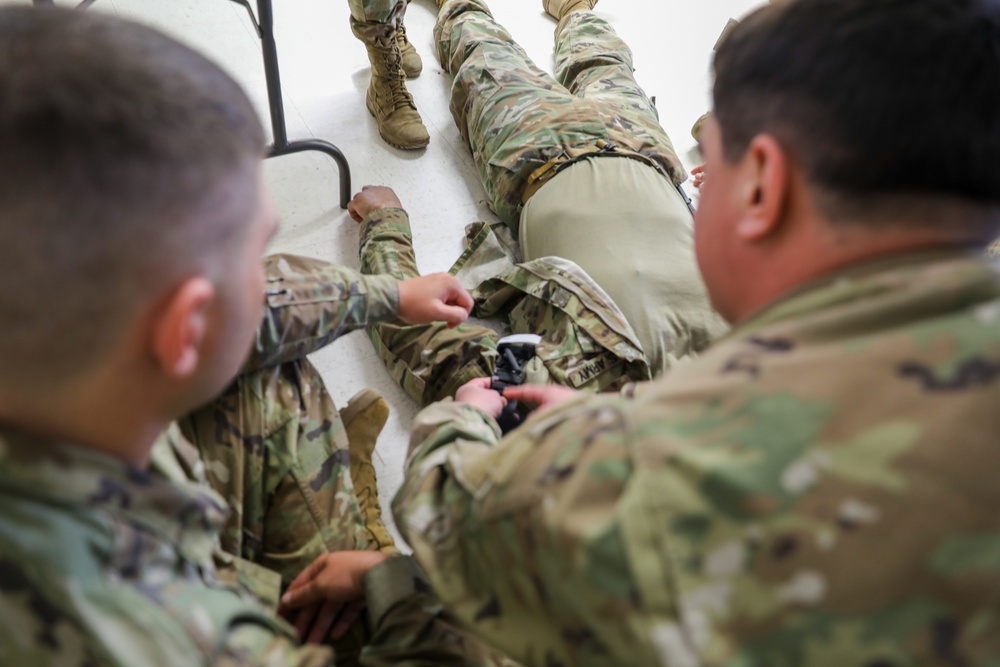DVIDS – News – 168th Wing flyaway demonstrates Agile Combat Employment Readiness
VOLK FIELD AIR NATIONAL GUARD BASE, Wis. – Air Crews, aircraft maintenance, operations, logistics, civil engineering, communications, security forces, and force support teams from the 168th Wing demonstrated the Air Force’s priority of Agile Combat Employment (ACE) during a flyaway readiness exercise April 1-7, 2023.
The ACE concept utilizes multi-capable Airmen to maintain, refuel and recover aircraft and ensure they are ready to deploy rapidly. The 168th Wing employed Multi-capable Airmen as part of their KC-135 Stratotanker operations, increasing survivability while generating combat air power.
“This exercise allowed us to practice several of the conceptual methods in which we may be asked to deploy and fight in the future,” said Lt. Col. Matthew McClurg, 168th Aircraft Maintenance commander. “We were able to cross-utilize AFSCs, particularly in maintenance, to broaden our capabilities with fewer people and with a smaller footprint toward the aircraft sortie generation effort.”
Four KC-135 Stratotankers from the Alaska Air National Guard 168th Wing, and one C-17 Globemaster from Alaska’s 176th Wing, departed from Eielson Air Force Base Alaska, with just over 100 Airmen and minimal equipment needed to conduct air refueling operations in an austere environment.
The 168th Wing set up operations at Volk Field, Wisconsin coordinating hangar and ramp space to simulate the challenges of an austere environment. The team had to become familiar with the installation and the limited resources available.
As operations were underway and MCA integrated into launching, recovering, refueling, and relaunching the tankers, rapidly turning the tankers with multiple sorties to meet up and refuel fighters.
“Both Staff Sgt. Kalib Dunlap from the R&R shop and Tech. Sgt. Kara Goodness-Tisland from the inspection shop were crew chiefs out on the line for this exercise,” said Tech Sgt. Cody Albert. “They are focused primarily on inspections and systems of the aircraft when at home station. They were both incredible while off-station. Kara and Kalib have both been deployed before, but the tempo of accomplishing this exercise was at a whole new level. Without them, we wouldn’t have been as successful as we were.”
Multiple refueling operations were accomplished from various locations across the United States, tied back to Volk and the home station in Alaska.
Exercise injects were created for realistic situations units would face in future conflicts, such as communications and equipment issues while operating out of airfields with limited or no ground support. Restricted network access and no installation familiarity would be among the challenges faced in future fights.
Hot pit refueling was another exercise objective carried out during the flyaway, making it a first for the 168th Logistics Readiness Squadron. Air Crew works with Maintenance and fuel teams to conduct refueling immediately after landing, while engines are still running, to reduce response times for the redeployment of the aircraft. Rapid Refueling is necessary to sustain the mission generating more combat air power.
Upon arriving at Volk Field, the teams quickly utilized the MCA concept they had been training for back at home station and set up operations with limited personnel to sustain operations.
“The Multi-Capable Airman program, while ponderously named, aims to increase our capabilities,” Master Sgt. David Fant, 168th Wing Crew Chief. “For maintenance teams, the MCA program enables more efficient operations while operating on the road, away from home station. The ability to step outside of our primary AFSC, learn more about the aircraft, and correctly identify and troubleshoot maintenance issues drastically reduces aircraft downtime by reducing our reliance on sending Maintenance Recovery Teams (MRT) out to recover aircraft.”
Maintenance back shop Airmen took to the flight line generating aircraft to send off for refueling. Communications Airmen conducted cyber security.
Civil Engineering crews set up operations for reserve osmosis water purification. The ROPWU is a water purification technology that uses a semipermeable membrane to remove ions, molecules, and larger particles from any water source to produce potable drinking water in an austere environment.
“What I found out with the MCA is that with my civilian job being HVAC in the Guard and civilian side, I was happy to do some plumbing,” said Senior Airman Mason Householder, 168th Civil Engineering. “I was excited when I heard about coming out here and getting this ROPWU set up. I had never seen anything like this, and I know the jist of plumbing; seeing how it works with larger pumps and the machine itself is helping me to contribute to the mission by being diverse in my skills. I am glad I can have the opportunity to work with the same squadron but in a different career field. I’m really glad to be able to tell the guys in Texas where I live what I have seen here.”
Security Forces secured the airfield and trained in clearing buildings. SFS extended their training to all career fields to expand on multi-capable Airmen operations.
Dirt boys trained on heavy equipment and rapid runway repair operations.
The Crash Damaged Disabled Aircraft Recovery unit responded to an aircraft on the simulated active runway needing to be cleared. The CDDAR team consisted of MCA from several career fields with all hands on deck to be in position using the mobile CDDAR equipment to simulate removing aircraft from the runway. The MCA team utilized lifting airbags, pneumatic manifolds, and air compressors. CDDAR is critical to operations because, without a conditioned program to recover, aircraft that have gone off the runway, crashed, or had landing gear failure are stuck on the runway preventing further flight operations and the aircraft from being recovered or put back into service.
Force Support Squadron, search and recovery team, led search and recovery procedures with Airmen from several career fields. SAR team members conducted a thorough search to identify and label any debris that would help investigation teams and body parts that would help mortuary affairs identify casualties. The training shows the airmen how to mark and recover all remains and personal effects after a casualty event. FSS ensured mortuary affairs operations and proper notification procedures were conducted.
The FSS team not only ensures Airmen arrive and depart the area of operations with full accountability but ensures they are fed and are bed down.
The Agile Combat Employment exercise is built upon MCA training at the home station. The austere unfamiliar environment expanded opportunities for Airmen to train and operate across each other’s career fields, ensuring operational success.
Air National Guard Airmen have drawn from their strengths as Guardsmen who often work in different civilian career fields than what they operate in the Air National Guard. Planning to execution of the exercise success is due to the nature of our Guard Airmen and their diversity in expertise.
The Multiple operations across Volk Field allowed for realistic training during the flyaway focusing on demonstrating the priority of Agile Combat Employment.
The 168th Wing’s primary mission is to provide KC-135 aircraft ready for year-round at a moment’s notice to support NORAD’s air sovereignty mission ensuring KC-135 tankers are readily available to provide aerial refueling throughout the world, including the Pacific and Arctic regions, including U.S. and allied aircraft.
| Date Taken: | 04.07.2023 |
| Date Posted: | 04.15.2023 19:06 |
| Story ID: | 442686 |
| Location: | VOLK FIELD AIR NATIONAL GUARD BASE, WI, US |
| Web Views: | 67 |
| Downloads: | 0 |
PUBLIC DOMAIN

This work, 168th Wing flyaway demonstrates Agile Combat Employment Readiness, by SMSgt Julie Avey, identified by DVIDS, must comply with the restrictions shown on https://www.dvidshub.net/about/copyright.


 Private Internet Access gives you unparalleled access to thousands
of next-gen servers in over 83 countries and each US state. Your
VPN experience will always be fast, smooth, and reliable.
Private Internet Access gives you unparalleled access to thousands
of next-gen servers in over 83 countries and each US state. Your
VPN experience will always be fast, smooth, and reliable.
